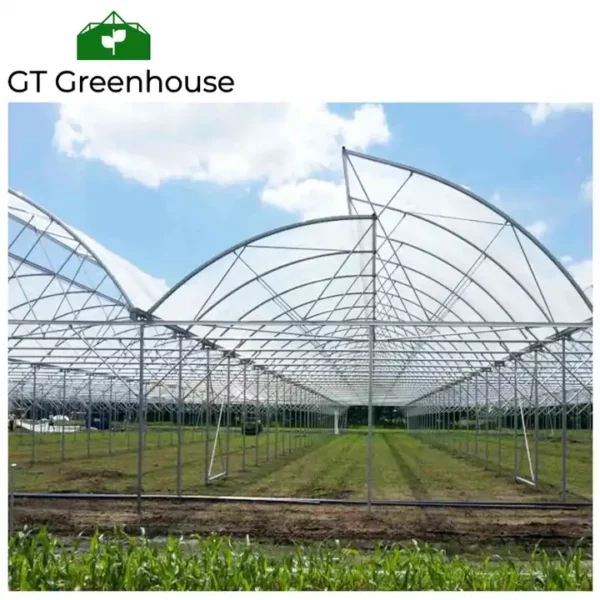A sawtooth greenhouse, also known as a sawtooth roof greenhouse, is a type of greenhouse structure characterized by a unique roof design resembling a row of sawteeth. The roof consists of a series of ridges and valleys that alternate in a sawtooth pattern along the length of the greenhouse. Each ridge typically has a vertical glazed surface facing south, while the valley side is often opaque or covered with insulating material.
Here are the sawtooth design serves several purposes and offers specific advantages for greenhouse cultivation:
- Natural Lighting: The vertical glazed surfaces of the ridges allow maximum sunlight penetration into the greenhouse. This design maximizes the exposure to natural light, especially from the south, optimizing photosynthesis and reducing the need for artificial lighting during daylight hours. The angled surfaces also help distribute light evenly throughout the greenhouse space.
- Temperature Regulation: The sawtooth roof design facilitates effective temperature regulation within the greenhouse. The vertical glazed surfaces facing the sun allow for efficient solar heat gain during colder periods, helping to maintain a favorable temperature for plant growth. The alternating opaque or insulated valley sides minimize excessive heat buildup, preventing overheating during warmer periods.
- Ventilation: The ridges of a sawtooth greenhouse can be designed with vents or louvers along the top, allowing for natural ventilation. Hot air rises and escapes through the vents, creating a natural airflow that helps to regulate temperature and humidity levels within the greenhouse. This ventilation system is especially beneficial in warmer climates or during the summer months.
- Energy Efficiency: The sawtooth design optimizes energy efficiency by reducing the reliance on artificial lighting and minimizing the need for heating and cooling systems. The strategic use of natural light and effective temperature regulation help to lower energy consumption and operational costs, making it an environmentally friendly choice for greenhouse cultivation.
- Aesthetic Appeal: The sawtooth roof design adds an architectural element to the greenhouse structure, giving it a distinct and visually appealing look. This unique design can enhance the overall aesthetic appeal of the greenhouse, making it an attractive feature in agricultural settings or even urban environments.
Sawtooth greenhouses are commonly used for a variety of agricultural purposes, including the cultivation of flowers, vegetables, and other greenhouse crops. Their efficient use of natural light, effective temperature regulation, and energy-saving features make them a popular choice for growers seeking sustainable and productive greenhouse environments.
What plants are suitable for growing in Sawtooth Greenhouse?
Sawtooth greenhouses are versatile structures that can accommodate a wide range of plants. The efficient use of natural light, temperature regulation, and ventilation provided by the sawtooth design create favorable conditions for various crops. Here are some plants suitable for growing in a sawtooth greenhouse:
- Tomatoes: Tomatoes thrive in the warm and sunny conditions provided by sawtooth greenhouses. The ample natural light helps in fruit development, while the temperature regulation prevents excessive heat. Sturdy trellises can be installed along the vertical glazed surfaces to support tomato vines.
- Cucumbers: Cucumbers are fast-growing plants that benefit from the warm and well-ventilated environment of a sawtooth greenhouse. They require ample sunlight and consistent temperatures, which can be achieved in this type of greenhouse. Vertical growing methods, such as trellising, work well for cucumbers in a sawtooth structure.
- Peppers: Peppers, whether sweet or hot varieties, thrive in the warm and sunny conditions provided by a sawtooth greenhouse. These plants require a good amount of sunlight and consistent temperatures to produce high-quality fruits. The natural ventilation in a sawtooth greenhouse helps control humidity levels, reducing the risk of disease.
- Leafy Greens: Lettuce, spinach, kale, and other leafy greens grow well in sawtooth greenhouses. These crops prefer cooler temperatures and can be grown in the shaded areas created by the alternating opaque or insulated valley sides of the sawtooth design. The natural ventilation helps maintain a crisp and healthy environment for leafy greens.
- Herbs: Many herbs, such as basil, parsley, cilantro, and mint, can thrive in a sawtooth greenhouse. These plants benefit from the ample sunlight and controlled temperatures provided by the greenhouse structure. Vertical gardening techniques or hanging baskets can be utilized to maximize space and optimize growth.
- Flowers: Various flowers, including roses, geraniums, petunias, and marigolds, can be successfully grown in sawtooth greenhouses. The abundant natural light and well-regulated temperatures create an ideal environment for flowering plants. The aesthetic appeal of a sawtooth greenhouse can be further enhanced by cultivating colorful and fragrant flowers.
- Climbing Plants: Sawtooth greenhouses are particularly suitable for climbing plants such as beans, peas, and various vine crops. The vertical glazed surfaces provide excellent support for the growth of these plants, allowing them to climb and spread. The natural ventilation helps prevent disease and ensures optimal growing conditions.
It’s important to note that specific growing techniques, such as trellising, pruning, and proper spacing, may be required for certain crops in a sawtooth greenhouse. Additionally, local climate conditions, seasonal variations, and individual plant preferences should be considered when selecting crops for cultivation in a sawtooth greenhouse.
